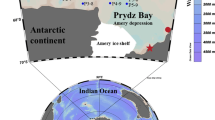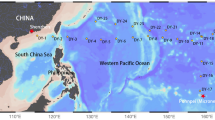Abstract
Seasonal variation of marine plankton spatial distribution is important in understanding the biological processes in the ocean. In this study, we studied spatial distribution of planktonic ciliate abundance and biomass in the central deep area (station depth greater than 60 m) and the coastal shallow area (station depth less than 60 m) of the southern Yellow Sea (32°–36.5°N, 121°–125°E) in spring (April) and autumn (October–November) of 2006. Our results showed that both ciliate abundance and biomass in the surface waters were higher in spring ((1 490±2 336) ind./L; (4.11±7.81) μg/L) than in autumn ((972±823) ind./L; (1.11±1.18) μg/L, calculated by carbon). Ciliate abundance and biomass in the surface waters of the coastal shallow area were similar in spring and autumn. However, in the central deep area, those values were much higher in spring ((1 878±2 893) ind./L; (5.99±10.10) μg/L) than in autumn ((738±373) ind./L; (0.74±0.76) μg/L). High values of ciliate abundance and biomass occurred in the central deep area in spring and in the coastal shallow area in autumn. Mixotrophic ciliate Laboea strobila was abundant in the central deep area in spring, when a phytoplankton bloom occurred. However, in autumn, L. strobila was abundant in the coastal shallow area. Boreal tintinnid Ptychocyli obtusa was found in spring. Both L. strobila and P. obtusa were concentrated in the surface waters when their abundance was more than 1 000 ind./L. Peaks of these species were in the subsurface waters when their abundance was less than 400 ind./L. This study showed that both high abundance and biomass of ciliates occurred in different areas in southern Yellow Sea seasonally.
Similar content being viewed by others
References
Dale T, Dahl E. 1987. Mass occurrence of planktonic oligotrichous ciliates in a bay in southern Norway. Journal of Plankton Research, 9(5): 871–879
Ding Junjun, Xu Kuidong. 2012. Community structure and distribution of pelagic nanoflagellates and ciliates and their relationship with jellyfish occurrence in southern Yellow Sea. Oceanologia et Limnologia Sinica (in Chinese), 43(3): 527–538
Dolan J R. 1991. Guilds of ciliate microzooplankton in the Chesapeake Bay. Estuarine, Coastal and Shelf Science, 33(2): 137–152
Dolan J R, Maarassé C. 1995. Planktonic ciliate distribution relative to a deep chlorophyll maximum: Catalan Sea, N. W. Mediterranean, June 1993. Deep Sea Research I: Oceanographic Research Papers, 42(11–12): 1965–1987
Dong Jun, Shi Fei, Li Han, et al. 2014. SSU rDNA sequence diversity and seasonally differentiated distribution of nanoplanktonic ciliates in neritic Bohai and Yellow Seas as revealed by T-RFLP. PLoS One, 9(7): e102640
Edwards E S, Burkill P H. 1995. Abundance, biomass and distribution of microzooplankton in the Irish Sea. Journal of Plankton Research, 17(4): 771–782
Gold K, Morales E A. 1975. Tintinnida of the New York Bight: Loricae of Parafavella gigantea, P. parumdentata, and Ptychocylis obtusa. Transactions of the American Microscopical Society, 94(1): 142–145
Gómez F. 2007. Trends on the distribution of ciliates in the open Pacific Ocean. Acta Oecologica, 32(2): 188–202
Ho C P, Wang Yuanxiang, Lei Zongyou, et al. 1959. A prelimenary study of the formation of Yellow Sea cold mass and its properties. Oceanologia et Limnologia Sinica (in Chinese), 2(1): 11–15
Kato S, Taniguchi A. 1993. Tintinnid ciliates as indicator species of different water masses in the western North Pacific Polar Front. Fisheries Oceanography, 2(3–4): 166–174
Kim Y O, Shin K, Jang P G, et al. 2012. Tintinnid species as biological indicators for monitoring intrusion of the warm oceanic waters into Korean coastal waters. Ocean Science Journal, 47(3): 161–172
Laval-Peuto M, Heinbokel J F, Anderson O R, et al. 1986. Role of micro- and nanozooplankton in marine food webs. International Journal of Tropical Insect Science, 7(3): 387–395
McManus G B, Fuhrman J A. 1986. Photosynthetic pigments in the ciliate Laboea strobila from Long Island Sound, USA. Journal of Plankton Research, 8(2): 317–327
Modigh M. 2001. Seasonal variations of photosynthetic ciliates at a Mediterranean coastal site. Aquatic Microbial Ecology, 23(2): 163–175
Montagnes D J S, Dower J F, Figueiredo G M. 2010. The protozooplankton-ichthyoplankton trophic link: an overlooked aspect of aquatic food webs. Journal of Eukaryotic Microbiology, 57(3): 223–228
Pierce R W. 1992. Ecology of planktonic ciliates in marine food webs. Rev Aquat Sci, 6(2): 139–181
Pierce R W, Turner J T. 1994. Plankton studies in Buzzards Bay, Massachusetts, USA: III. Denoflagellates, 1987 to 1988. Marine Ecology Progress Series, 112: 225–234
Putt M. 1990. Abundance, chlorophyll content and photosynthetic rates of ciliates in the Nordic Seas during summer. Deep Sea Research Part A. Oceanographic Research Papers, 37(11): 1713–1731
Putt M, Stoecker D K. 1989. An experimentally determined carbon: volume ratio for marine "oligotrichous" ciliates from estuarine and coastal waters. Limnology and Oceanography, 34(6): 1097–1103
Stoecker D K, Silver M W, Michaels A E, et al. 1988. Obligate mixotrophy in Laboea strobila, a ciliate which retains chloroplasts. Marine Biology, 99(3): 415–423
Stoecker D K, Taniguchi A, Michaels A E. 1989. Abundance of autotrophic, mixotrophic and heterotrophic planktonic ciliates in shelf and slope waters. Marine Ecology Progress Series, 50: 241–254
Strickland J D H, Parsons T R. 1972. A practical Handbook of Seawater Analysis. Ottawa: Fisheries Board of Canada, 167
Sun Song, Zhang Fang, Li Chaolun, et al. 2015. Breeding places, population dynamics, and distribution of the giant jellyfish Nemopilema nomurai (Scyphozoa: Rhizostomeae) in the Yellow Sea and the East China Sea. Hydrobiologia, 754(1): 59–74
Tang Qisheng, Su Jilan, Zhang Jing, et al. 2013. Spring blooms and the ecosystem processes: the case study of the Yellow Sea. Deep Sea Research II: Topical Studies in Oceanography, 97: 1–3
Utermöhl H. 1958. Zur Vervollkommnung der Quantitativen Phytoplankton-Methodik: Mit 1 Tabelle und 15 abbildungen im Text und auf 1 Tafel. Internationale Vereinigung fur Theoretische und Angewandte Limnologir: Mitteilungen, 9(1): 1–38
Yu Fei, Zhang Zhixin, Diao Xinyuan, et al. 2006. Analysis of evolution of the Huanghai Sea Cold Water Mass and its relationship with adjacent water masses. Haiyang Xuebao (in Chinese), 28(5): 26–34
Yu Ying, Zhang Wuchang, Zhang Cuixia, et al. 2014. Basin-scale variation in planktonic ciliate distribution: a detailed temporal and spatial study of the Yellow Sea. Marine Biology Research, 10(7): 641–654
Zhang Wuchang, Feng Meiping, Yu Ying, et al. 2012. Illustrated Guide to Contemporary Tintinnids in the World (in Chinese). Beijing: Science Press, 1–499
Zhang Wuchang, Xu Kuidong, Wan Ruijing, et al. 2002. Spatial distribution of ciliates, copepod nauplii and eggs, Engraulis japonicus postlarvae and microzooplankton herbivorous activity in the Yellow Sea, China. Aquatic Microbial Ecology, 27(3): 249–259
Zhang Cuixia, Zhang Wuchang, Xiao Tian, et al. 2008. Mesoscale spatial distribution of large tintinnids in early summer in southern Yellow Sea. Chinese Journal of Oceanology and Limnology, 26(1): 81–90
Zhang Cuixia, Zhang Wuchang, Xiao Tian, et al. 2009. Wintertime mesoscale horizontal distribution of large tintinnids in the southern Yellow Sea. Chinese Journal of Oceanology and Limnology, 27(1): 31–37
Zhang Wuchang, Yu Ying, Xiao Tian. 2015. An Illustrated Guide to Marine Planktonic Aloricate Oligotrich Ciliates (in Chinese). Beijing: Science Press, 1–135
Acknowledgments
The authors thank the captain and crews of R/V Beidou for their assistance in the sample collection during the cruises.
Author information
Authors and Affiliations
Corresponding author
Additional information
Foundation item: The National Natural Science Foundation of China (NSFC) under contract Nos U1606404 and 41576164; the Strategic Priority Research Programs under contract No. XDA11020103.1.
Rights and permissions
About this article
Cite this article
Zhang, S., Li, H., Chen, X. et al. Differences in planktonic ciliate spatial distribution in spring and autumn in the southern Yellow Sea. Acta Oceanol. Sin. 37, 48–57 (2018). https://doi.org/10.1007/s13131-018-1147-y
Received:
Accepted:
Published:
Issue Date:
DOI: https://doi.org/10.1007/s13131-018-1147-y




